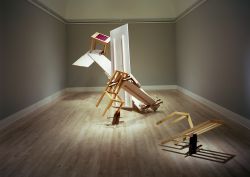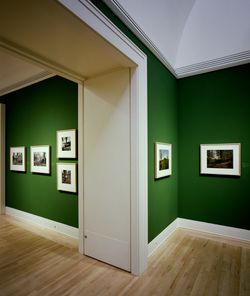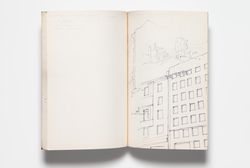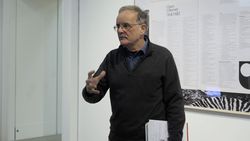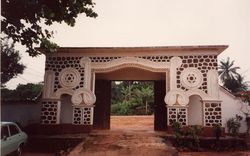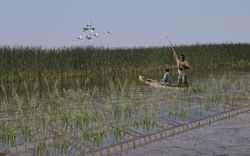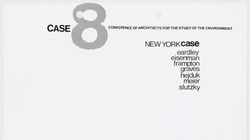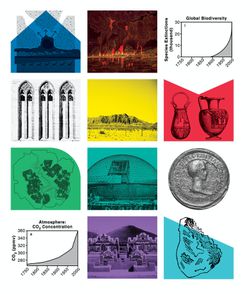Series
Collection personnelle
AP001.S2
Description:
Cette série contient les collections personnelles d'Ernest Cormier comprenant des livres, peintures, gravures, et cartes postales. La bibliothèque de Cormier illustre ses intérêts en art, décoration, musique, littérature, langues, histoire, et mathématiques. La bibliothèque comprend aussi la littérature technique relative à l'architecture et à l'ingénierie. La série inclut des notes écrites par Cormier relatives à sa bibliothèque, et des documents trouvés dans ses livres.
non daté, 1885-1977
Collection personnelle
Actions:
AP001.S2
Description:
Cette série contient les collections personnelles d'Ernest Cormier comprenant des livres, peintures, gravures, et cartes postales. La bibliothèque de Cormier illustre ses intérêts en art, décoration, musique, littérature, langues, histoire, et mathématiques. La bibliothèque comprend aussi la littérature technique relative à l'architecture et à l'ingénierie. La série inclut des notes écrites par Cormier relatives à sa bibliothèque, et des documents trouvés dans ses livres.
Série
non daté, 1885-1977
Parables and Other Allegories: The Work of Melvin Charney 1975–1990 comprises approximately 100 drawings, including many large-scale, sketches, photographs, and three large constructions. By assembling works from various public and private collections, including the CCA, the exhibition permits a comprehensive analysis of Charney’s artistic process to reveal the dialogue(...)
Main galleries
9 October 1991 to 12 January 1992
Parables and Other Allegories: The Work of Melvin Charney, 1975-1990
Actions:
Description:
Parables and Other Allegories: The Work of Melvin Charney 1975–1990 comprises approximately 100 drawings, including many large-scale, sketches, photographs, and three large constructions. By assembling works from various public and private collections, including the CCA, the exhibition permits a comprehensive analysis of Charney’s artistic process to reveal the dialogue(...)
Main galleries
exhibitions
The terms contemplation, solitude, exile, leisure, rest, retreat, reverse, and solitude—and their antonyms action, court, world, worldliness and society—constitute a recurring chain of ideas in seventeenth-century fictional and biographical literature. From Society to Solitude combines history, literature, and architecture, focusing on the theme of the retreat and its(...)
Hall cases
12 October 1994 to 15 January 1995
From Society to Solitude: Public and Private Space in Seventeenth-Century France
Actions:
Description:
The terms contemplation, solitude, exile, leisure, rest, retreat, reverse, and solitude—and their antonyms action, court, world, worldliness and society—constitute a recurring chain of ideas in seventeenth-century fictional and biographical literature. From Society to Solitude combines history, literature, and architecture, focusing on the theme of the retreat and its(...)
exhibitions
12 October 1994 to
15 January 1995
Hall cases
Through a commission from the CCA, three contemporary photographers spent six years interpreting the work of Frederick Law Olmsted (1822–1903), North America’s most important landscape architect. *Viewing Olmsted: Photographs by Robert Burley, Lee Friedlander, and Geoffrey James* presents 155 photographs from this commission to offer visitors an opportunity to understand(...)
Main galleries
16 October 1996 to 2 February 1997
Viewing Olmsted: Photographs by Robert Burley, Lee Friedlander, and Geoffrey James
Actions:
Description:
Through a commission from the CCA, three contemporary photographers spent six years interpreting the work of Frederick Law Olmsted (1822–1903), North America’s most important landscape architect. *Viewing Olmsted: Photographs by Robert Burley, Lee Friedlander, and Geoffrey James* presents 155 photographs from this commission to offer visitors an opportunity to understand(...)
Main galleries
Visiting Scholar Seminar: Gregorio Carboni Maestri
Portugal: Architecture, Tendenza, Revolution
Visiting Scholar Gregorio Carboni Maestri presents his research. From the 1930s to the late 1980s, Portuguese architecture was formed through a frustrated relationship with modernity and through a crucial dialogue with Italy. This talk addresses how Portuguese architecture observed and reacted to Italian models such as rationalism in the 1930s, postwar neorealism, and(...)
Shaughnessy House Keyword(s):
Gregorio Carboni Maestri, Visiting Scholar, Portugal, Tendenza
3 August 2017, 6pm
Visiting Scholar Seminar: Gregorio Carboni Maestri
Actions:
Description:
Visiting Scholar Gregorio Carboni Maestri presents his research. From the 1930s to the late 1980s, Portuguese architecture was formed through a frustrated relationship with modernity and through a crucial dialogue with Italy. This talk addresses how Portuguese architecture observed and reacted to Italian models such as rationalism in the 1930s, postwar neorealism, and(...)
Shaughnessy House Keyword(s):
Gregorio Carboni Maestri, Visiting Scholar, Portugal, Tendenza
Soon after the opening of The University Is Now on Air: Broadcasting Modern Architecture, Tim Benton presents another reading of the new exhibition through a counter-tour. Rather than a tour through the galleries that gives voice to the curator’s ideas, counter-tours propose critical, subversive, corrective, or alternative versions of a given project through encounters(...)
16 November 2017
Counter-tour: Tim Benton’s Cut
Actions:
Description:
Soon after the opening of The University Is Now on Air: Broadcasting Modern Architecture, Tim Benton presents another reading of the new exhibition through a counter-tour. Rather than a tour through the galleries that gives voice to the curator’s ideas, counter-tours propose critical, subversive, corrective, or alternative versions of a given project through encounters(...)
articles
Where Was Not Modernism?
Where Was Not Modernism?
Ikem Stanley Okoye redefines the origins of African modernism
Actions:
The St. Peter’s Indian Band (now Peguis First Nation) was forcibly removed from their original lands at Netley-Libau Marsh beginning in 1908, after an illegal surrender vote took place. Since then, the health of the area that was once the Peguis’s home has declined due to intense annual flooding and ice jams; the appearance of invasive species such as purple loosestrife,(...)
online Keyword(s):
Indigenous-led design, fellow, Peguis First Nation, land rehabilitation
27 April 2023, 6:00 to 7:30 p.m.
Peguis First Nation and the Netley-Libau Marsh: Documenting Indigenous Land Use and Occupancy at the Mouth of Lake Winnipeg
Actions:
Description:
The St. Peter’s Indian Band (now Peguis First Nation) was forcibly removed from their original lands at Netley-Libau Marsh beginning in 1908, after an illegal surrender vote took place. Since then, the health of the area that was once the Peguis’s home has declined due to intense annual flooding and ice jams; the appearance of invasive species such as purple loosestrife,(...)
online Keyword(s):
Indigenous-led design, fellow, Peguis First Nation, land rehabilitation
Visiting Scholar Susanne Bauer presents her research: The theoretical debates which took place in American architecture circles—predominantly those on the east coast—as of the early 1960s were often concerned with questions of formal analysis of architectural space and, more broadly, with the present state of architecture and the disciplines future. Some of these debates(...)
Shaughnessy House
21 July 2016, 6pm
Visiting Scholar Seminar: Susanne Bauer
Actions:
Description:
Visiting Scholar Susanne Bauer presents her research: The theoretical debates which took place in American architecture circles—predominantly those on the east coast—as of the early 1960s were often concerned with questions of formal analysis of architectural space and, more broadly, with the present state of architecture and the disciplines future. Some of these debates(...)
Shaughnessy House
Since 2006, the Aggregate Architectural History Collaborative has engaged in numerous shared projects from collected volumes and joint authorship to peer review workshopping and website publishing, alongside conferences, symposia, and public presentations. Operated as a self-funded, non-profit corporation, Aggregate continues to evolve its means and outputs of production(...)
13 July 2023, 2pm to 4pm (EST)
Modes and Bounds of Collaboration
Actions:
Description:
Since 2006, the Aggregate Architectural History Collaborative has engaged in numerous shared projects from collected volumes and joint authorship to peer review workshopping and website publishing, alongside conferences, symposia, and public presentations. Operated as a self-funded, non-profit corporation, Aggregate continues to evolve its means and outputs of production(...)
